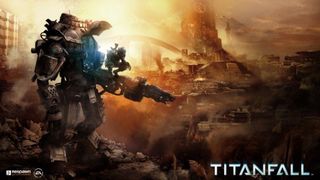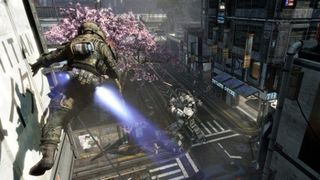
Out of the plethora of first person shooters saturating the market Titanfall stands out because like the genre defining games that came before, it understands the most overlooked critical genre mechanic, movement. Why movement? Are shooters not just about accurately directing bullets into the face of your foe? Nay I say! From my pulpit I declare the over emphasis on the shooting degrades the genre. If we look back at our roots like Doom and Quake it is not the shooting which stands out, but the extreme legerity, complexity, and technicality of the movement. Doomguy runs 57 miles an hour. Spectating a Quake match is like witnessing two ballerinas dance off, whilst trying to kill each other with rocket launchers. In Quake, players run like cheetahs amped on growth hormone, vault from ledges, bunny hop across the map, and skillfully rocket jump to the next platform. Within a few moments of watching a Counter-Strike player I can determine their skill level just by watching them move. Tribes Ascend's skiing allows skilled players to plot advance routes through the map, elevating the entire capture the flag mode to awesome competitive heights. Movement is the lost art of FPS design. It's the single most important mechanic. Just hopping in and moving around is fun in a good shooter.
A pilot, Titanfall's title for a player character, runs faster on walls than on floors. Why? Because running on walls makes for awesome gameplay. If you're not running on a wall, jumping to the next, and continuing your route, you are playing Titanfall wrong. If you are on ground level, you are playing Titanfall wrong. Complex movement in Titanfall is easier for a newcomer to perform than in Quake or Counter-Strike. It's as simple as running at a wall and jumping into it. However, Titanfall's parkour jump system is reminiscent of Tribes in that routes matter. Advanced players can chain wall runs and jumps together to fling across the maps like Spider-Man.
Due to astronomically high costs of modern triple A game development, most games' mechanical design must factor in the limitations of controllers. The common lethargic pace of movement in modern shooters can be mostly blamed on the inherent inaccuracies of analog sticks. Titanfall solves this problem with weapons like the smart pistol. While most guns still require iron sights, unfortunately forcing firing and moving to become separate actions, the smart pistol, which automatically locks on and kills targets when hip-fired, allow players to take full advantage of the mobility the mechanics offer. Utilizing the smart pistol one never has to slow down the pace of their assault.

The Source engine is the Millennium Falcon of game engines, she may not look like much but she's got it where it counts. Utilizing the Source engine may not make Titanfall the prettiest next generation shooter, but like the rest of the design choices Titanfall cares primarily about gameplay. Source's netcode is tight as a hipster's pants. Rumor has it Titanfall's tickrate, updates to the game world between server and client per second, is around 30. While not an ideal tickrate, Source can do a lot with 30 ticks. My time with the beta felt smooth, with no noticeable lag issues. This will come as a welcome relief to anyone who experienced the Battlefield 4 netcode debacle. Source reminds of my old Toyota Land Cruiser, old and reliable, which is great for a game emphasizing high frame rates over high fidelity visuals. The amazing animation and incredible moment-to-moment action means players will hardly notice the less than stellar textures.
Again, it all comes back to game play. A lot of shooters' try to incentivize play by offering countless unnecessary unlockables, which only clutter players' inventories with redundant weapons. Counter-Strike: Global Offensive provides an excellent model to emulate, where each weapon maintains a specific role and function. Titanfall follows in this vein by providing approximately two choices per roll. Instead of a ridiculous weapon count, the game focuses on balance. This ideology is seen throughout Titan and Pilot customization as well. The more recent Call of Duty titles have seen ever expanding “perk creep”, where builds become ridiculous and balance suffers. The streamlined nature of the Titanfall perk system means lot's of viable options, while maintaining power equity across unlockables.
From what we've experienced in beta the map design follows the same gameplay first ideological underpinnings. The levels' science fiction qualities are grounded and subtle, whilst still being internally coherent. The scifi architecture feels familiar without being boring. The flat surfaces call out to you, begging to be wall-run on, but they never feel artificially placed, rather they feel like a natural extension of the science fiction landscape. This design is refreshing after years of games with awkwardly placed chest high walls. Each location of the map has unique identifiers, like bill boards or hotel names, so callouts become natural. You'll hear your allies call out “Enemy above nexus!” and there will be no doubt as which of the numerous rooftops your opponent is lurking.

6 versus 6 matchmaking means no longer suffering the belligerence of strangers once one finds a good group to play with. Titanfall's barrier of entry is extremely low. Many of my friends are intimidated by Counter-Strike. Others enjoy the action RTS genre games like DoTA2 and League of Legends. Titanfall unites the once distant tribes under one game. Finally, something everyone can enjoy. NPC minions create an interesting combination of genres. Not only do they provide spectacle, but less talented friends can contribute greatly to a team victory in attrition mode by rapidly poping the NPC minions like balloons. However, I do wish the AI was more threatening, because outside of attrition mode the optimal strategy seems to be avoiding them entirely.
Here I am foaming at the mouth with anticipation and I haven't even written about the Titans. Battlefield taught us the joy of diversity of play. Are you sick of running and gunning? How about driving a tank into Battle? Use of vehicles is like putting two games into one. Whenever one gameplay element becomes stale, just switch into a new role. Titanfall's Titans are a natural extension of this concept, but their utility feels harmonious with pilot play. Whereas placing vehicles in a multiplayer shooter can feel like bolting a separate vehicle combat game into an FPS, the Titans play like a slow, more methodological shooter. With Titans, Titanfall puts another shooter into your shooter. Titan survivability is a welcome pace change from the instant time to kill pilots suffer. Balance is again key, because while Titan firepower and survivability is much greater than pilots, they are still constantly under threat from the pilot mobility. Rarely do I fist pump air, but just try not to after running across multiple walls, jumping through a battle, mounting an enemy Titan, ripping open his weak spot, and destroying him with a machine gun. Titanfall is not merely content with this incredible moment. Oh no. When your enemy explodes you're launched into the air as if strapped to Wile E Coyote's Acme rocket. From 200 feet up you're free to survey the battlefield, seeking new large mechanical victims.
Titanfall constantly provides these moments of pure insane fun. During my time with beta I cannot count how many times I uttered and heard the descriptive phrase, “I cannot believe THAT just happened.” Titanfall is the most exciting shooter of 2014 because all aspects of design are focused on fun first. It's gameplay centric. Strange that in 2014, that choice feels so novel. Prepare to drop here .

PC Gamer Newsletter
Sign up to get the best content of the week, and great gaming deals, as picked by the editors.
